Mack Brothers Custom Rifle Review: A Lightweight Hunting and Competition Crossover
We may earn revenue from the products available on this page and participate in affiliate programs. Learn More ›
Mack Brothers isn’t a household name among hunters and shooters, but among discerning riflemen the company has an excellent reputation. Curiously, the brand also has quite a following among some shooters who have never heard of it. That’s because for many years Mack Brothers has produced top-quality actions for other gun makers, labeled with those companies’ brands, such as Nosler and GA Precision.
Happily, the company is no longer hiding its light under a bushel and is now marketing its actions and custom rifle builds directly to the shooting world. When Mack Brothers announced it was making rifles in 2023 I jumped at the chance to get a gun built to my specifications.
What I ended up with is, to my way of thinking, the ultimate crossover rifle for hunting and NRL Hunter-style competition: a lightweight 6.5 Creedmoor on a Manners MCH Pro Hunter stock that’s optimized for practical field shooting with next-level accuracy, ergonomics, and reliability.
The cherry on top is the stock features a unique tiger-stripe paint job, giving a personalized twist to the custom package.
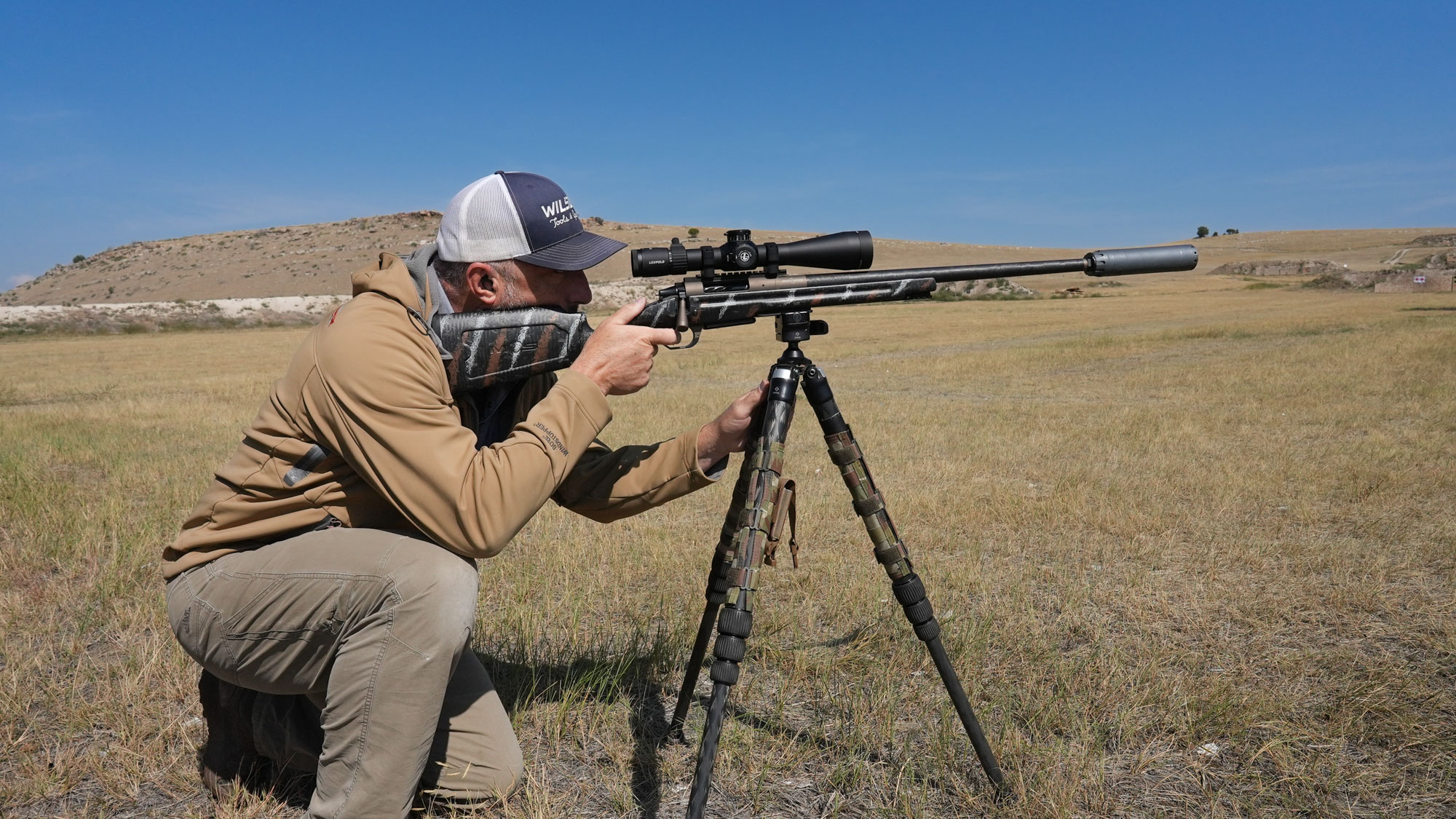
Photo by John B. Snow
Mack Brothers Custom Rifle Specs
- Action: Mack Brothers Evo II two-lug bolt action
- Stock: Manners MCH Pro Hunter carbon fiber
- Barrel: Carbon Six 22-inch Sendero carbon fiber, threaded 5/8-24, 1:7.5 twist
- Bottom Metal: Mack Brothers DBM
- Cartridge: 6.5 Creedmoor
- Capacity: 5+1
- Finish: Smoked Bronze Cerakote (receiver), nitride (bolt)
- Weight: 7 pounds (measured)
- Trigger: TriggerTech Diamond set to 1 pound, 5 ounces (measured)
- Length: 42 inches (measured)
- Price: From $4,995, depending on options
Key Features
- Takes either AICS or AW magazines
- ARCA rail in front of magazine well
- Recessed Pic rail on fore-end to mount a bipod
- QD cup sling attachment points
- 20 MOA full-length Pic rail on action
- Modified M16 style extractor
- Toolless bolt takedown
Review Highlights
- Lightweight, precision rifle with terrific accuracy
- Smooth, reliable action
- Excellent ergonomics on action and stock
- Fine craftsmanship, and fit and finish
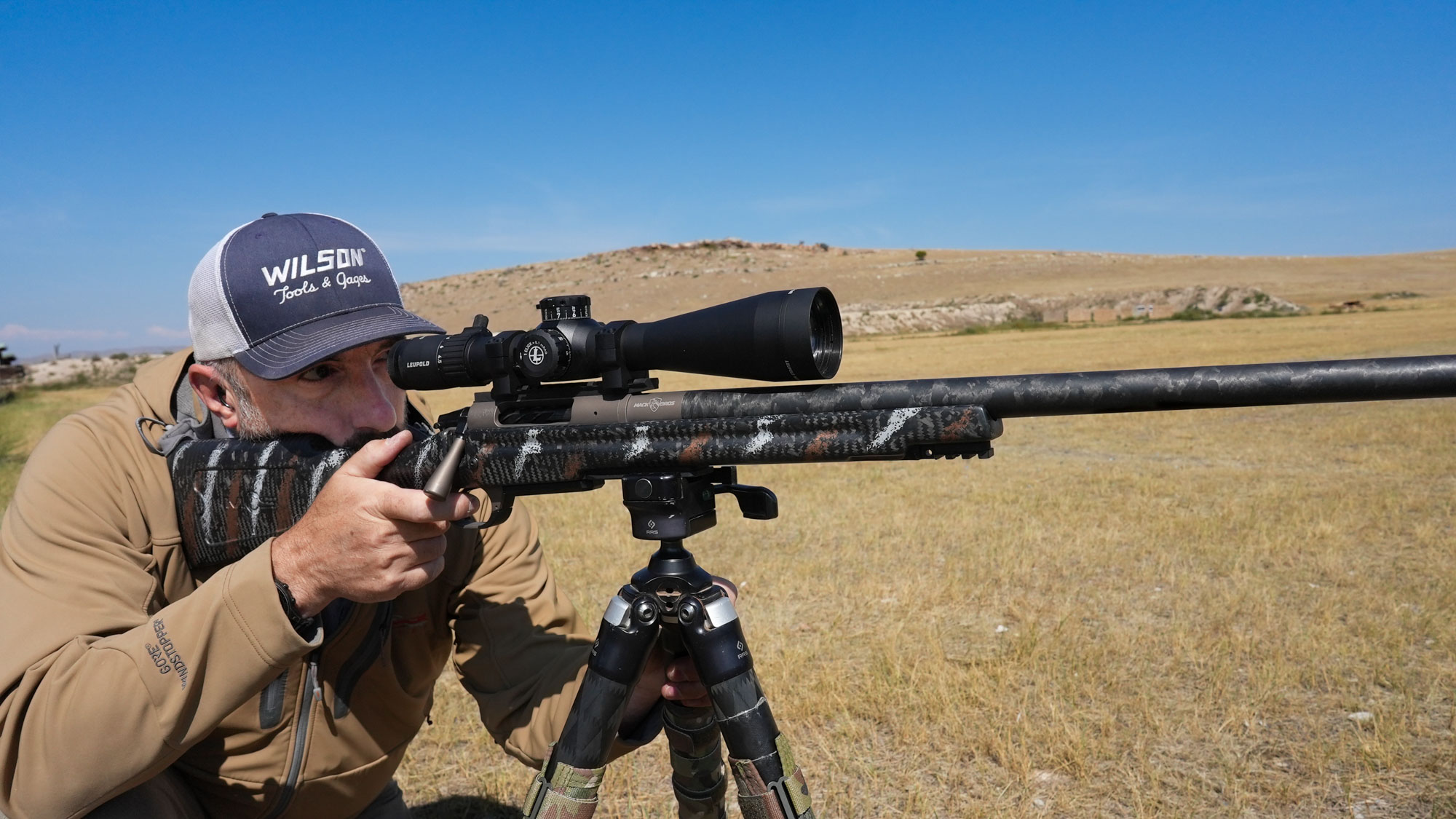
Photo by John B. Snow
Mack Brothers Custom Rifle Accuracy
The five-shot group average is .633 inches, representing nine different types of ammo and 26 groups total. The 10-shot average was .820 inches.
The rifle likes to be driven aggressively and shot better with firm pressure, pulling the stock back into my shoulder and moderate cheek pressure on the comb. As always, taking the slack out of the bipod — loading it by leaning into the rifle and moving it forward until the bipod legs reach their natural limit of travel — ensures better precision, too.
Mack Brothers Evo II Action
The heart of the rifle is Mack Brothers’ Evo II two-lug bolt action. This is a Remington 700 pattern system with numerous upgrades that have become de rigueur on high-end precision rifles.
These include: A self-indexing recoil lug, for repeatability and accuracy; streamlined external bolt stop; one-piece nitride bolt body with weight-reducing cuts; 20 MOA Pic rail (on actions for detachable box magazines); threaded and pinned bolt handle; trigger hanger; toolless bolt takedown; and M16-style extractor.
Mack Brothers makes the Evo II from either 416 stainless (28.5 ounces) or, at a 28 percent reduction titanium (20.5 ounces). Although I wanted my rifle to be as light as possible — both for ease of carry and to help it make the 12-pound cutoff weight for NRL Hunter matches — I opted for the stainless action.
I went that route because the stainless action can be cut to accommodate both AICS and AW style box magazines, while the titanium version can only run AICS box mags. (The double-stack AW magazines are more compact than the single-stack AICS mags, which can be an advantage in competition when trying to maneuver in tight spaces or when the rifle is clipped into a tripod.)
Also, stainless steel actions generally run more smoothly than titanium, though the Mack Brothers titanium actions I’ve played with are pleasingly slick and don’t stick or chatter.
Evo II Action Operation
The bolt on my Evo II glides back and forth in an almost effortless fashion. Even though there is a little play in the bolt when it is pulled to the rear of the receiver it doesn’t bind up or hesitate in the slightest no matter how much lateral pressure I exert on the bolt handle.
The cocking motion is smooth as well. The force required to lift the bolt handle and cock the action remains consistent through its 90 degrees of travel, making for an even, predictable movement.
This refined design enhances the rifle’s shootability and reliability. Whether running the rifle unsupported or off a shooting bag it is easy to cycle the action and stay on target.
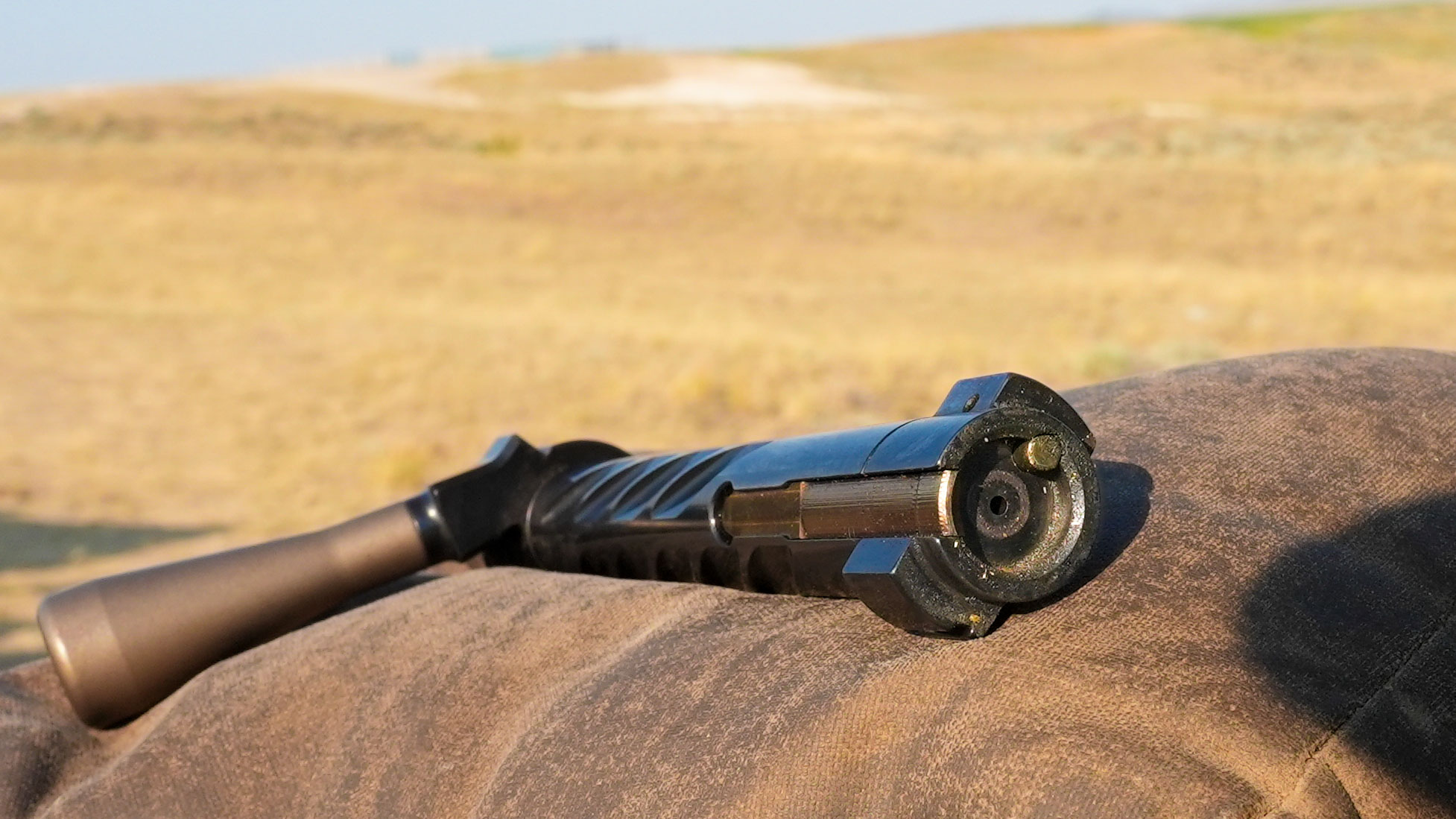
Photo by John B. Snow
Push-Feed Design
Like a traditional Remington 700, the Evo II is a push-feed system. But unlike an old-school 700, which has an extractor that sits within the bolt head and is supported 360-degrees around, the EVO II has a long and robust M16-style extractor that lies within a cut in the bolt head.
Some people gripe about the old 700 extractor design, faulting it for being too skimpy. I’ve never had any serious issues with the 700s I’ve owned and shot over the years, but if you aren’t convinced, chances are you will love the beefy EVO II extractor.
Another thing to like about the EVO II’s extractor is its simplicity. It acts as its own spring, eliminating a potential failure point in a traditional M16 design.
In any event it has functioned flawlessly for me, as has the single plunger ejector, which kicks empties out of the action with reassuring force.
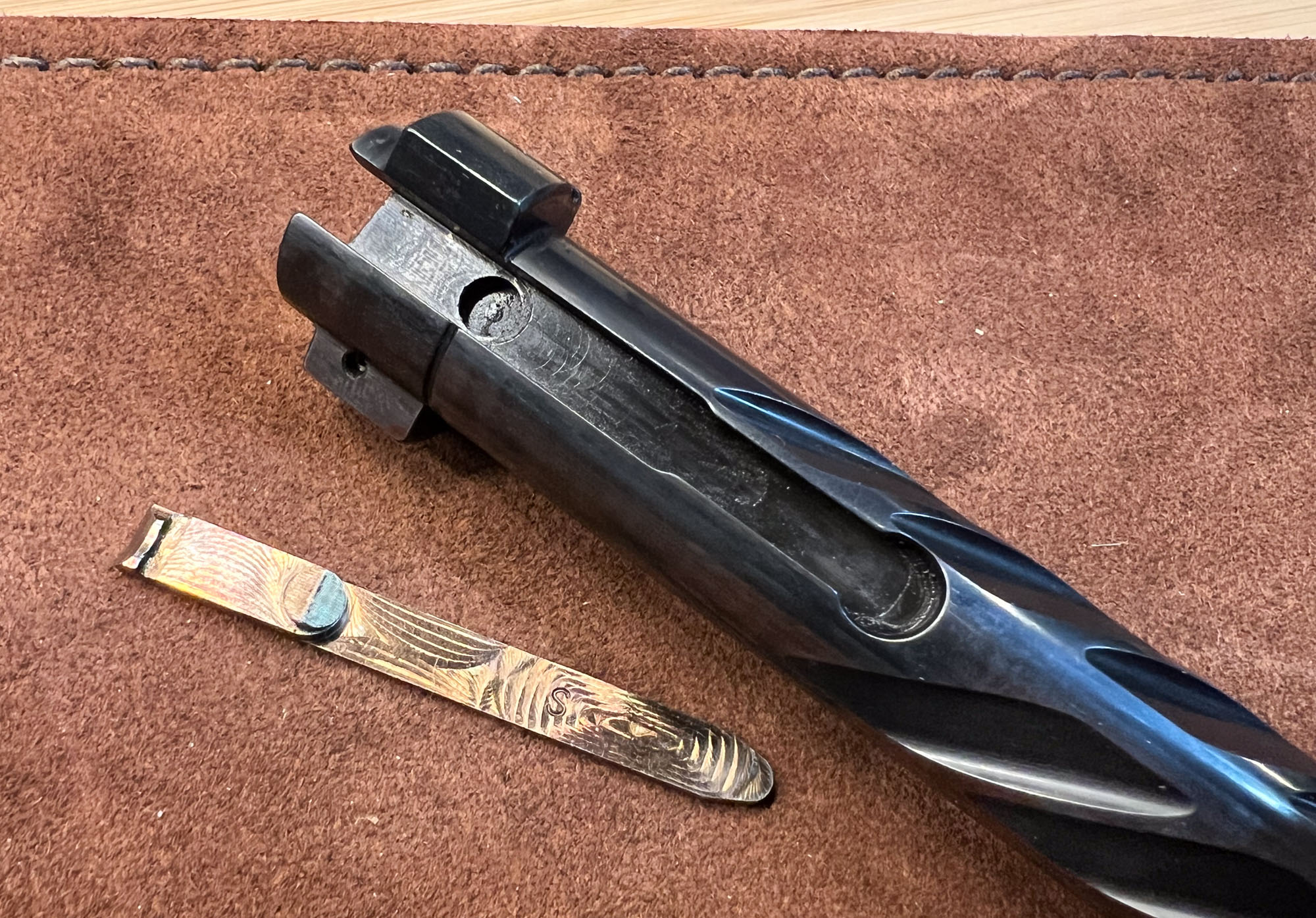
Photo by John B. Snow
Servicing the Bolt
Removing the bolt from the receiver is easy. The bolt-stop tab is low profile and doesn’t require much effort to depress, letting you pull the bolt free.
The firing pin assembly can be removed from the Evo II with a strong twist to the bolt shroud, which disengages the lugs that hold it in place. The amount of effort to undo mine was substantial, so if you have a difficult time removing yours just twist harder.
This gives access to the firing pin, firing pin spring, and the interior of the bolt body for cleaning and maintenance.
You can also remove the extractor by leveraging it up with a flat screwdriver bit and sliding it forward. When doing this you have to flex the extractor enough so that the nub on the extractor clears the recess it sits in. Also make sure the bit you use is narrower than the cut in bolt face where the extractor sits or you won’t be able to lift it high enough to accomplish the task.
Removing the extractor lets you clean out bits of brass shavings and fouling that can accumulate under the extractor blade and around the case head. To reassemble, put the extractor in its slot and slide it back until it clicks into place. This takes significant force, so you will have to push it against a bench or other surface. I suggest dabbing a drop or two of gun oil on the extractor to help it on its way.
Magazine Versatility: AICS or AW
My rifle came with a low-profile Hunter magazine from Hawkins Precision. It’s a center-feed magazine that holds five rounds of 6.5 Creedmoor and extends just a third of an inch below the magazine well. Like all Hawkins’ offerings, it is well built and attractive.
Putting five shells in it made for a tight fit and caused a bit of bolt drag, but I was still able to load the gun without difficulty.
For basic range work and hunting this magazine is perfect, but the bottom metal, which is Mack Brothers’ own design, is able to accommodate both AW and AICS magazines too.
These are perfect for competition where you might have 10 or more rounds in a stage. I used magazines from multiple companies — MDT, Magpul, Accuracy International, Accurate-Mag — and didn’t have trouble with any of them.
I especially appreciate being able to run the 10-round AW magazines in the rifle since they are unobtrusive, feed great, completely bombproof, easy to load, and easy to service.

Photo by John B. Snow
Mack Brothers DBM Bottom Metal
There are numerous styles of bottom metal for detachable box magazines with many different magazine catch systems. The Mack Brothers DBM is about the most elegant of the lot and is perfect for a crossover hunter-competition rifle.
It operates a bit like a traditional paddle release, except the wings of the paddle don’t extend outside the trigger guard. Instead, they are integrated into the trigger guard and sit flush within it. It gives the bottom metal and trigger guard a smooth, clean look.
The spring in the release is stiff enough that it will never move on its own but can be easily actuated with the trigger finger. When the release is pushed forward, the magazines drop free of their own accord and never stick inside the well.
Longer AICS magazines rattle a bit side to side in the well, but all other mags I’ve run have been snug and quiet.
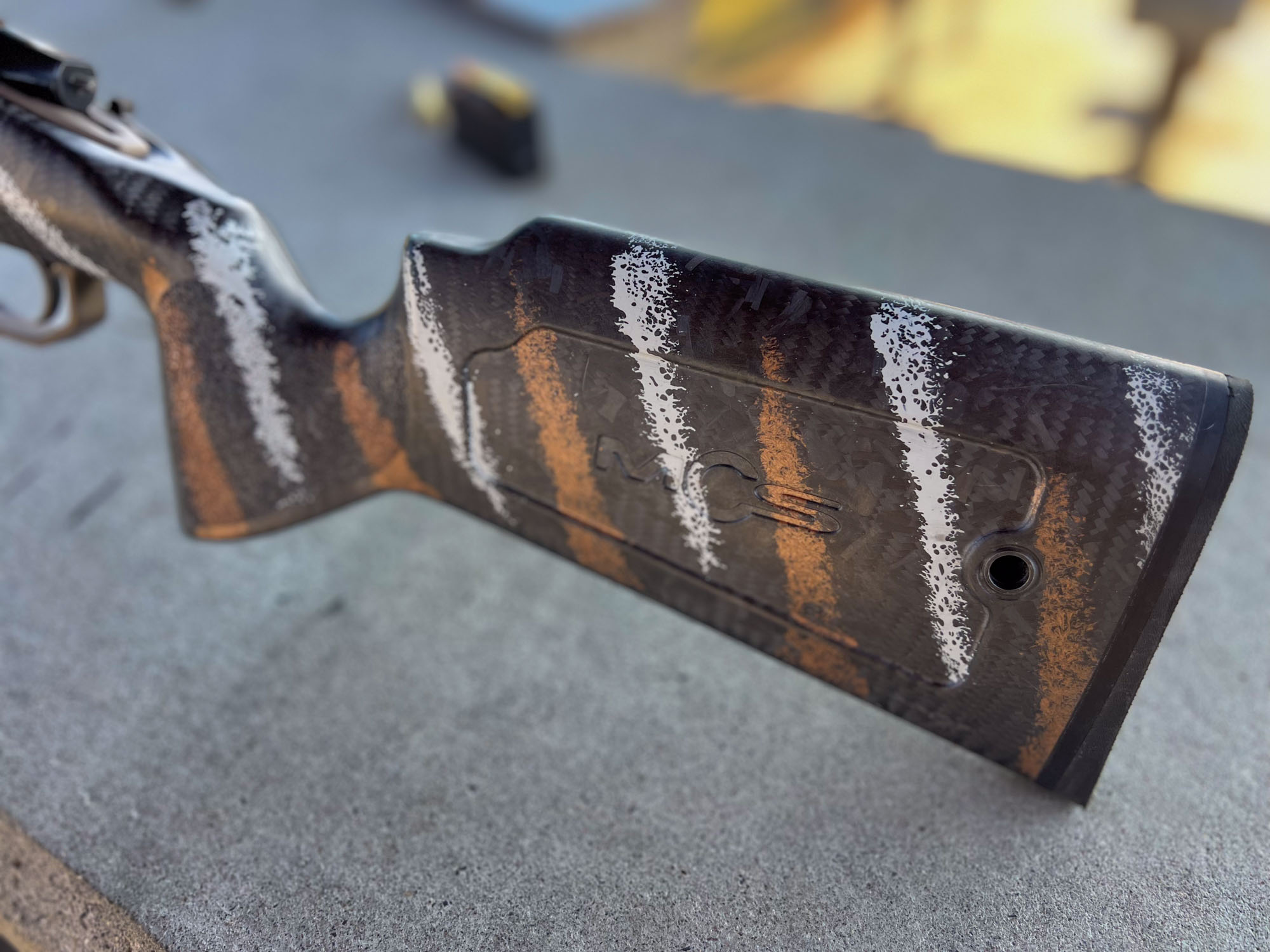
Photo by John B. Snow
Manners MCH Pro Hunter Stock
More than any other rifle component, stocks have exploded in recent years in terms of the sheer number of available options. There are solutions for pretty much any type of shooting, budget, and personal preference.
As a modern hunting stock, I think the Manners MCH Pro Hunter has few, if any, equals. It checks a number of boxes that I value, incorporating features from the competition and precision rifle scene in a lightweight design that is right at home on a demanding backcountry hunt.
These elements include:
- Nearly vertical pistol grip with ambidextrous palm swells
- Ambidextrous thumb shelves
- QD cup sling attachments
- Flat fore-end with recessed Picatinny rail section for bipod
- Grooves on either side of stock for improved grip
- ARCA rail in front of mag well
- Flat comb
- Integral aluminum chassis
The benefits of many of these features are obvious. The integral chassis provides rigidity to the connection between the action and stock, enhancing precision. The flat fore-end is useful for taking aim off a shooting bag. The ARCA rail lets you clip directly into a tripod, allowing for excellent accuracy from an elevated position. The recessed Pic rail and QD cups make the stock less likely to hang up on gear or vegetation.
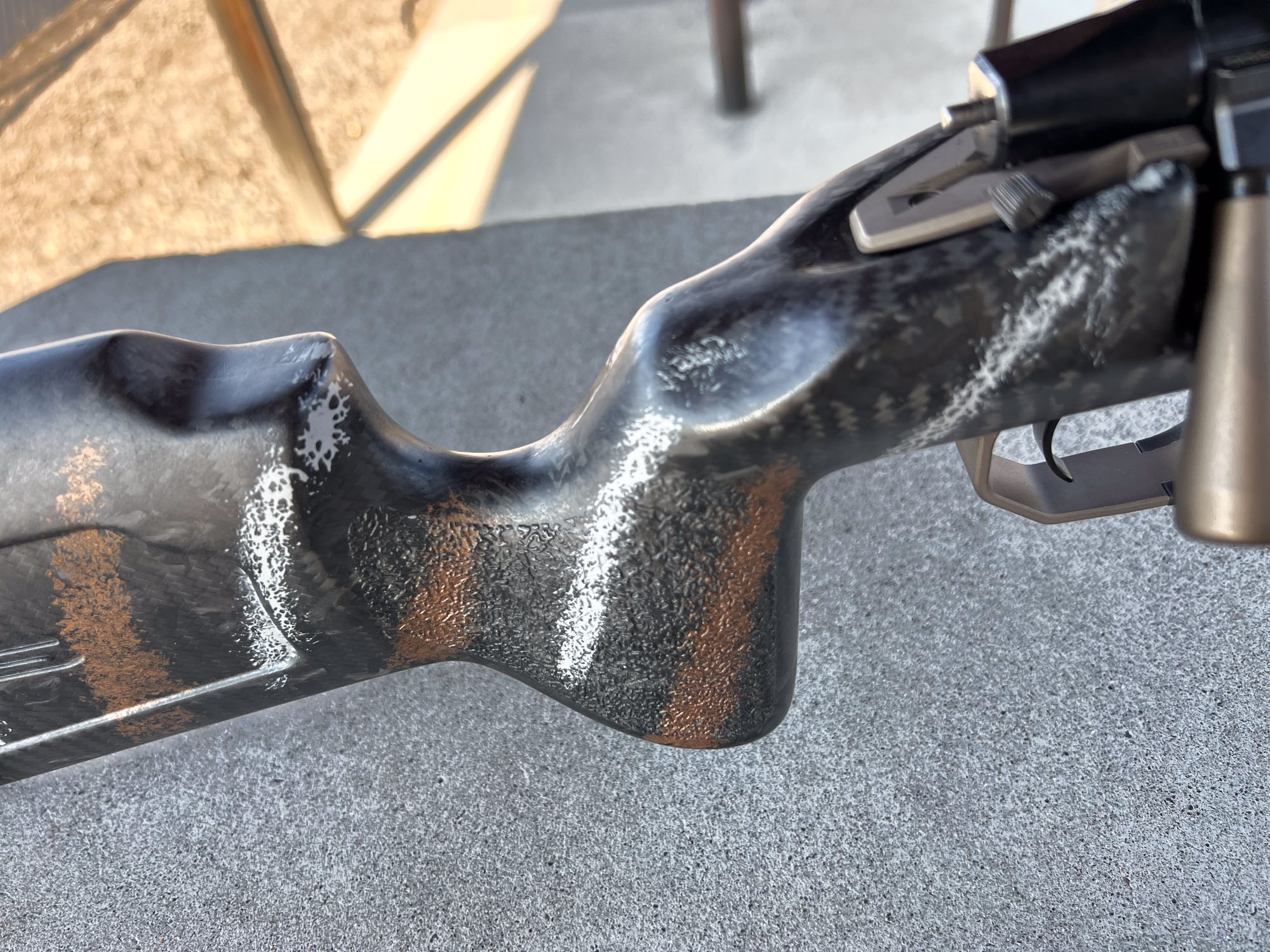
Photo by John B. Snow
Light, Yet Strong
Constructed from a carbon-fiber shell, the Pro Hunter weighs just 1 pound 13 ounces, yet is as inflexible and rigid as a hanging judge. I saved some weight on the stock by going with a thin recoil pad with rubber that’s only about a quarter-inch thick. Since the rifle is chambered in the eminently shootable 6.5 Creedmoor, it doesn’t need more cushioning than that to deal with the recoil.
Even though the barreled action tips the scales at 4 pounds 12.6 ounces, the whole rifle is just 7 pounds with an empty magazine installed.
Read Next: The Best Rifle Bipods of 2024, Tested and Reviewed
When configured for NRL Hunter competition, with an MDT Ckye-Pod bipod, suppressor, and precision rifle scope, the rifle weighs just 10.5 pounds, giving me lots of leeway to add a more robust bipod (like the MDT Triple Pull) and other accessories like a timer, dope card, and bubble level.
I also really like the stock geometry. The pistol grip fills the shooting hand and positions the trigger finger in perfect alignment with the trigger face. The fixed comb places my head right where it needs to be, so there’s no strain when looking down a scope mounted with medium-height rings.
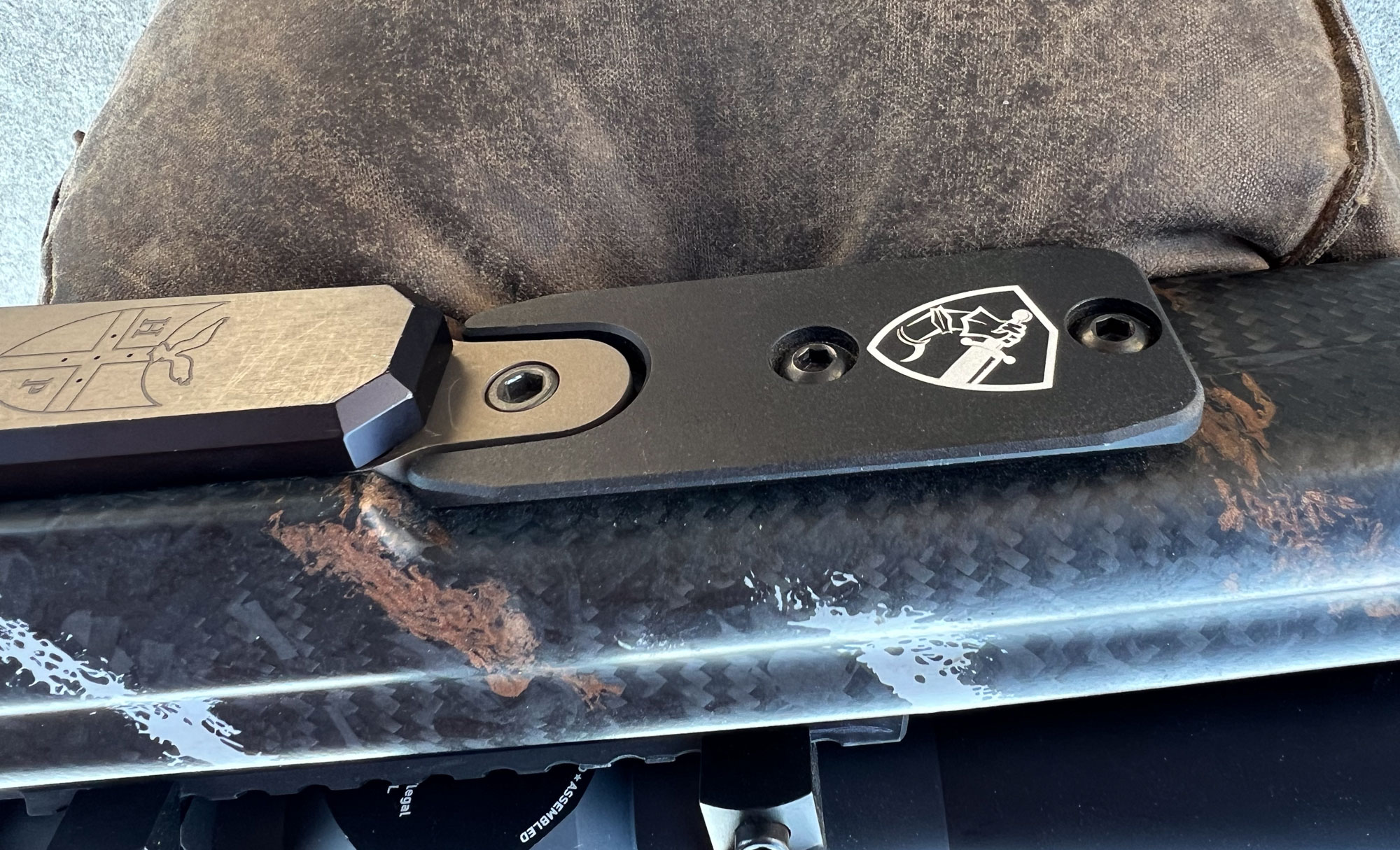
Photo by John B. Snow
Manners, which has always had a solid reputation for the quality of their stocks, continues to refine their manufacturing techniques. With my stock I was struck by how nicely the raised texture on either side of the grip was executed. In a similar vein, the seam between the two halves of the stock shell is barely noticeable. The stock also emits a flat, dead sound when flicked with a finger or hit with a branch, rather than the loud hollow ring that some high-end carbon fiber stocks give off.
Lastly, the stock is painted with a custom tiger-stripe pattern that compliments the smoked bronze Cerakoting on the receiver, bottom metal, thread protector, and bolt handle. The rifle is a looker, which is something everyone should expect from an expensive custom rig.
Carbon Six Barrel
Prior to getting this rifle I only had fleeting experience with Carbon Six barrels. I’d shot a handful of rifles with their barrels in the past but had never spent meaningful time with one or put one to the test.
The barrel on my rifle delivered excellent accuracy with every load I put through it. It has a Sendero profile and came threaded 5/8-24. I shot it a bit initially with just the thread protector screwed on, but quickly opted to run it with different lightweight suppressors for the majority of the evaluation, specifically a Thunder Beast Ultra 7, Gunwerks Six Ti, and Banish Backcountry.
The point of impact shift with these suppressors on board was minimal, but enough that you’d want to adjust your zero for long distance shooting when going from unsuppressed to suppressed fire.
The barrel has a 1:7.5 twist, which works great for a range of 6.5mm bullets but shines with projectiles weighing around 140-grains or more.
Because I plan to use the rifle in NRL Hunter competition I went with a 22-inch barrel giving me a good compromise between muzzle velocity and nimble handling with a can attached.
If I were just going to use this as a suppressed hunting rig, I would have opted for a 20- or possibly even 18-inch barrel. But because the NRL Hunting series specifies a minimum power factor with handloads I wanted a little extra barrel length.
When configuring a rifle from Mack Brothers you can specify the barrel length. The options go from 18 to 26 inches in two-inch intervals, which covers many applications.
Mack Brothers Custom Rifle In The Field
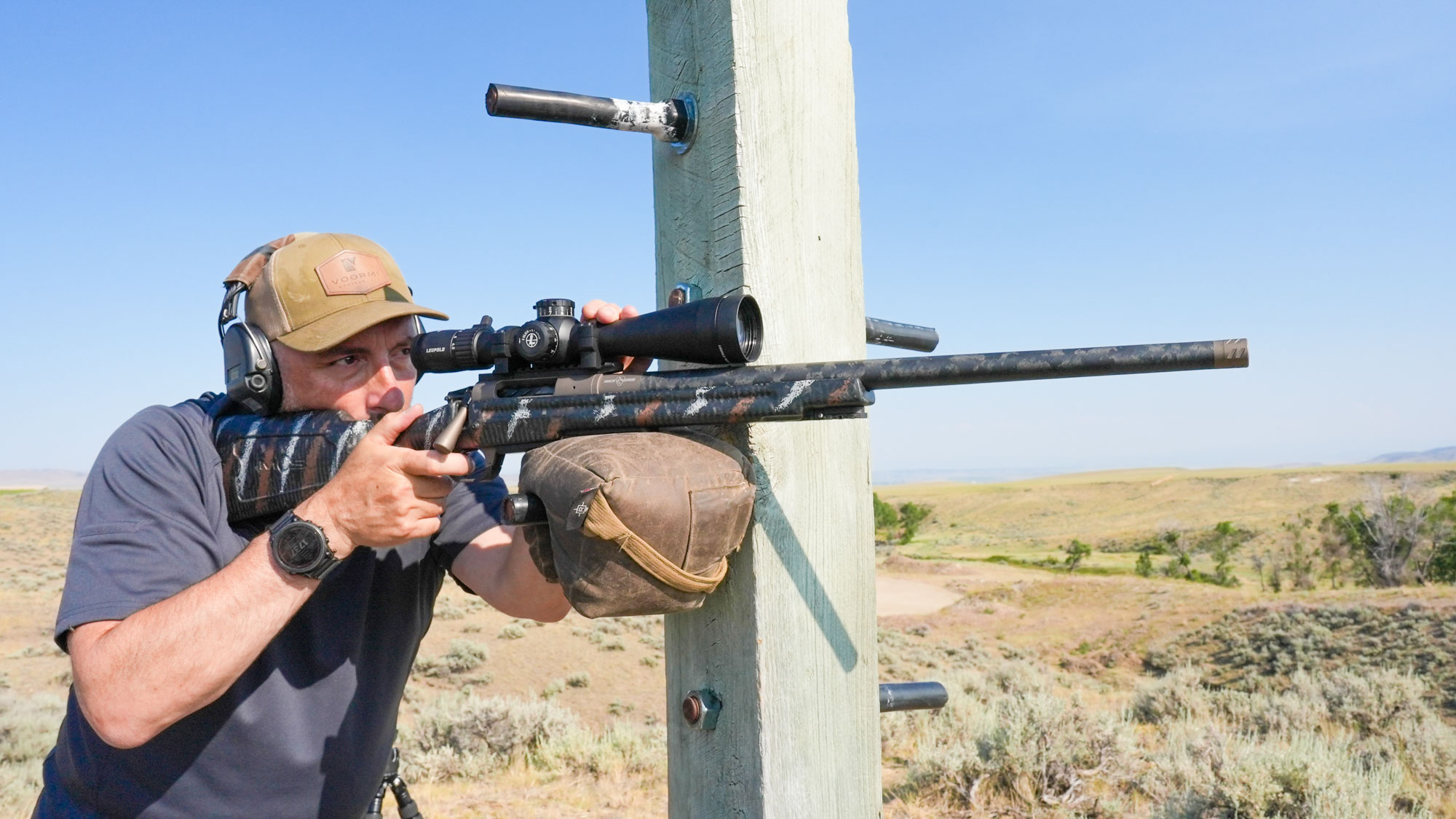
Photo by John B. Snow
Shooting tiny groups is one of life’s undeniable pleasures. And my Mack Brothers Custom certainly delivered on this front. Off the bench it printed groups from .327 inches to 1.026 inches, with the bulk in the .4s, .5s, and .6s.
That performance at 100 yards, coupled with the rifle’s excellent ergonomics and smooth action translated to capable long-range steel smacking. Whether shooting prone, where I engaged steel past 1,100 yards, or shooting positionally at sub-1,000-yard targets, the rifle handled like a gem.
It is very well mannered, and I found it easy to maintain my sight picture and call my shots, and then cycle the gun quickly for the next engagement.
From the standpoint of practical field marksmanship, it is a remarkably capable rig, one I would gladly hunt or compete with.
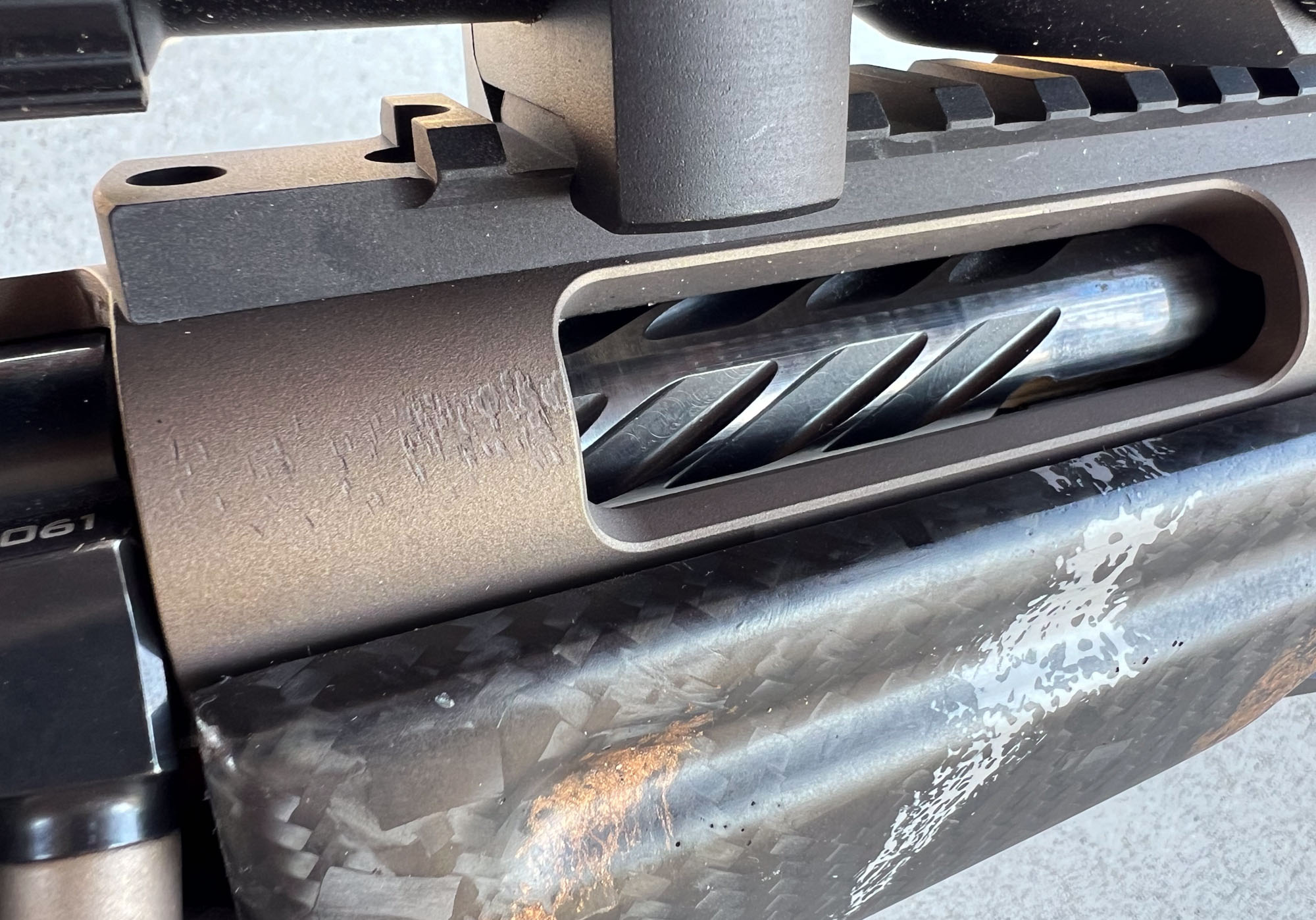
Photo by John B. Snow
Mack Brothers Custom Rifle Durability
My confidence in the rifle was boosted by how durable it has proven to be over the last year. I’ve put several hundred rounds though the rifle and have never had any kind of issue with how it feeds, shoots, ejects, and cycles.
Given the number of rounds I’ve put through it, the rifle exhibits some well-earned wear, but nothing that indicates any kind of problem or potential concern.
The edges on the Picatinny rail on the fore-end are a little burnished. The nitride coating on the bolt is a bit worn, and the receiver just behind the ejection port has a bunch of tiny dings where the brass, spun around by the strong ejector, hits the receiver. Otherwise, the rifle is as flawless as the day I took delivery.
Mack Brothers Custom Rifle Pros and Cons
As a certifiably crabby gun writer I delight in pointing out the flaws and foibles of the firearms I review. It helps keep gun makers who are used to universally-fawning coverage in check and gives potential buyers a clear-eyed account of what to expect.
This Mack Brothers rifle is therefore a bit of a disappointment since there isn’t really anything to gripe about. The only issue I experienced is when loading its five-round magazine to capacity. The cartridges were a little tight and chambering the first round took a bit of extra effort.
The only other negative of the rifle is the price, which is prohibitive for many. But even at five grand, the rifle is a good value, delivering the kind of performance and craftsmanship one expects at that level but that many other high-dollar rifles don’t.
The pros of the rifle are numerous. It is light and handy. It is accurate and easy to shoot. It is tough and should provide many years of hard use. You can easily service it in the field. And it is a pleasure to look at.
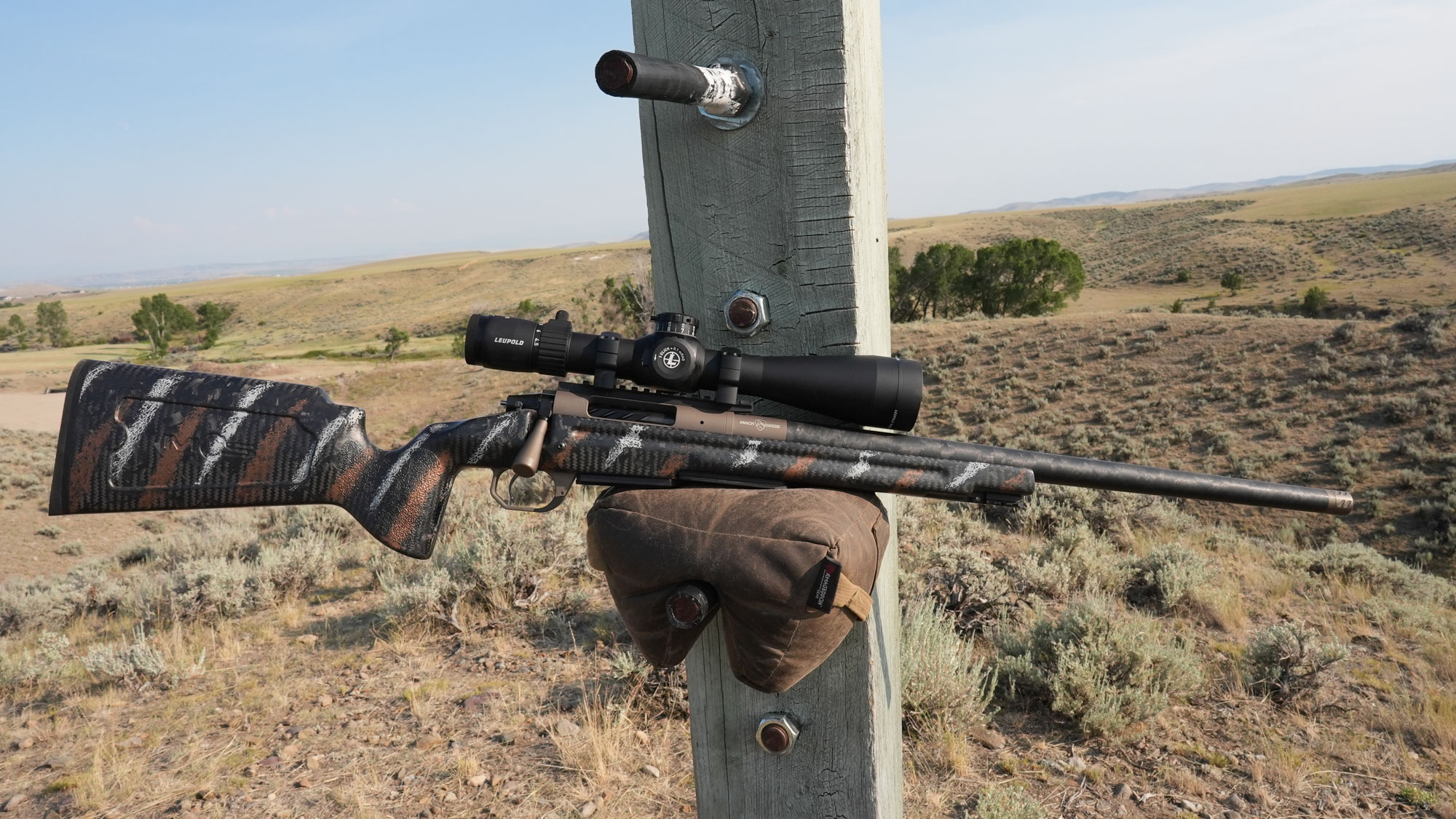
Photo by John B. Snow
Final Thoughts
I’m glad to see Mack Brothers getting into the rifle making business. Their actions, suppressors, and other accessories have helped them establish a solid reputation since the company was founded by brothers Allen and Dale Mack back in 2007.
Currently they offer four different rifles to choose from: a traditional looking rifle, one with a collapsible stock, a lightweight crossover rifle for hunting and competition similar to mine, and a muzzleloader.
Read Next: The Best Rifles of 2024, Tested and Reviewed
That mix covers a lot of different types of customers, but the models share a similar design philosophy. They all incorporate top-notch features, materials, and ergonomics that have come to define our highest quality, and best performing, rifles.
It’s clear that Mack Brothers understands the high-end rifle market and knows which features are meaningful enhancements, and therefore should be included, and those that are gimmicks to be avoided.
I would never want to be forced to own just one rifle. What a dull existence that would be. But if I did have to choose, this rifle would be on a very short list of contenders.
The post Mack Brothers Custom Rifle Review: A Lightweight Hunting and Competition Crossover appeared first on Outdoor Life.
Source: https://www.outdoorlife.com/guns/mack-brothers-custom-rifle-review/





